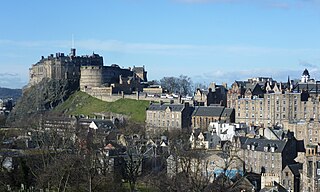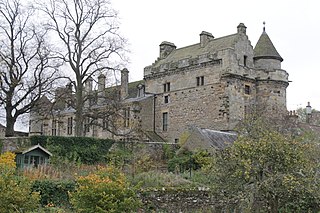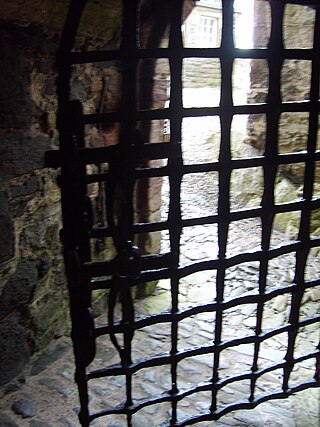
Edinburgh Castle is a historic castle in Edinburgh, Scotland. It stands on Castle Rock, which has been occupied by humans since at least the Iron Age. There has been a royal castle on the rock since at least the reign of Malcolm III in the 11th century, and the castle continued to be a royal residence until 1633. From the 15th century, the castle's residential role declined, and by the 17th century it was principally used as a military garrison. Its importance as a part of Scotland's national heritage was recognised increasingly from the early 19th century onwards, and various restoration programmes have been carried out over the past century and a half.

Stirling Castle, located in Stirling, is one of the largest and most historically and architecturally important castles in Scotland. The castle sits atop an intrusive crag, which forms part of the Stirling Sill geological formation. It is surrounded on three sides by steep cliffs, giving it a strong defensive position. Its strategic location, guarding what was, until the 1890s, the farthest downstream crossing of the River Forth, has made it an important fortification in the region from the earliest times.
The title Earl of Winton was created in the Peerage of Scotland and later in the Peerage of the United Kingdom. It is currently held by the Earl of Eglinton.

Falkland Palace, in Falkland, Fife, Scotland, is a royal palace of the Scottish Kings. It was one of the favourite places of Mary, Queen of Scots, who took refuge there from political and religious turmoil of her times.

Huntingtower Castle, once known as Ruthven Castle or the Place of Ruthven, is located near the village of Huntingtower beside the A85 and near the A9, about 5 km NW of the centre of Perth, Perth and Kinross, in central Scotland, on the main road to Crieff. This castle is the subject for several local ghostlore stories.

Ludovic Stewart, 2nd Duke of Lennox and 1st Duke of Richmond, lord of the Manor of Cobham, Kent, was a Scottish nobleman who through their paternal lines was a second cousin of King James VI of Scotland and I of England. He was involved in the Plantation of Ulster in Ireland and the colonization of Maine in New England. Richmond's Island and Cape Richmond as well as Richmond, Maine, are named after him. His magnificent monument with effigies survives in Westminster Abbey.
William Armstrong of Kinmont or Kinmont Willie was a Scottish border reiver and outlaw active in the Anglo-Scottish Border country in the last decades of the 16th century.
The Raid of Ruthven, the kidnapping of King James VI of Scotland, was a political conspiracy in Scotland which took place on 23 August 1582. It was composed of several Presbyterian nobles, led by William Ruthven, 1st Earl of Gowrie, who abducted the king. The nobles intended to reform the government of Scotland and limit the influence of French and pro-Catholic policy, and to prevent or manage the return of Mary, Queen of Scots from England to rule with her son in an "association". Their short-lived rule of around 10 months is known as the "Ruthven" or "Gowrie Regime".

Claud Hamilton, 1st Lord Paisley was a Scottish nobleman who fought at the Battle of Langside in 1568 for Mary, Queen of Scots. He is the ancestor of the earls, marquesses and dukes of Abercorn.

Tantallon Castle is a ruined mid-14th-century fortress, located 5 kilometres (3.1 mi) east of North Berwick, in East Lothian, Scotland. It sits atop a promontory opposite the Bass Rock, looking out onto the Firth of Forth. The last medieval curtain wall castle to be constructed in Scotland, Tantallon comprises a single wall blocking off the headland, with the other three sides naturally protected by sea cliffs.

Berwick Castle is a ruined castle in Berwick-upon-Tweed, Northumberland, England.
Archibald Douglas, Parson of Douglas, was also Parson of Glasgow, a Senator of the College of Justice, Ambassador to Queen Elizabeth I of England, and a notorious intriguer.
William Schaw was Master of Works to James VI of Scotland for building castles and palaces, and is claimed to have been an important figure in the development of Freemasonry in Scotland.

A yett is a gate or grille of latticed wrought iron bars used for defensive purposes in castles and tower houses. Unlike a portcullis, which is raised and lowered vertically using mechanical means, yetts are hinged in the manner of a traditional gate or door, and secured by bolts attached to the yett, or by long bars drawn out from the wall or gateway.

The Renaissance in Scotland was a cultural, intellectual and artistic movement in Scotland, from the late fifteenth century to the beginning of the seventeenth century. It is associated with the pan-European Renaissance that is usually regarded as beginning in Italy in the late fourteenth century and reaching northern Europe as a Northern Renaissance in the fifteenth century. It involved an attempt to revive the principles of the classical era, including humanism, a spirit of scholarly enquiry, scepticism, and concepts of balance and proportion. Since the twentieth century, the uniqueness and unity of the Renaissance has been challenged by historians, but significant changes in Scotland can be seen to have taken place in education, intellectual life, literature, art, architecture, music, science and politics.

Architecture in early modern Scotland encompasses all building within the borders of the kingdom of Scotland, from the early sixteenth century to the mid-eighteenth century. The time period roughly corresponds to the early modern era in Europe, beginning with the Renaissance and Reformation and ending with the start of the Enlightenment and Industrialisation.

Cavers Castle, also known as Cavers House, is a ruined tower house located at Cavers, Scottish Borders, Scotland. Cavers Castle was a much extended tower house of the Douglas family dating back to the 15th or 16th century, and built upon the site of an earlier stronghold of the Balliols. It was repeatedly attacked during the 16th century wars with England, and substantially remodelled in the 17th century to form a mansion house, itself extended and remodelled in baronial style by Peddie and McKay in the 1890s. It was eventually deroofed and partially demolished in the 1950s, and was sold most recently in 2019. There are developing plans to restore the building, which is a listed building.

Widdrington is a village and a civil parish in the county of Northumberland, England. It borders Tritlington and West Chevington and East Chevington parishes to the north, the North Sea to the east, Cresswell and Ellington and Linton parishes to the south, and Widdrington Station and Stobswood parish to the west. In 2011 the parish has a population of 167.
William Murray of Tullibardine was a Scottish courtier and leader of the Clan Murray.

Thomas Musgrave, Captain of Bewcastle was an English landowner and soldier involved in Scottish border politics. He was keeper of Bewcastle Castle for Elizabeth I.















